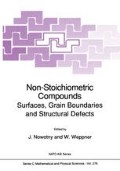Abstract
Based upon studies of the electrical conductivity and Seebeck coefficient of TiO2- and MgO-doped Cr2O3, the point defect structure of Cr2O3 was determined. It is found that the defect and transport properties in Cr2O3 are complicated. At high temperatures, different defects may be present depending upon the oxygen partial pressure. In general, at high PO2, Cr2O3 is a p-type semiconductor with electron holes and chromium vacancies as the dominant defects; at intermediate PO2, it behaves as an intrinsic semiconductor with electrons and electron holes dominant; and at low PO2, near the Cr/Cr2O3 equilibrium oxygen pressure, it changes to an n-type semiconductor with electrons and chromium interstitials dominant. The equilibrium constants associated with the formation of different defects are also obtained.
Access this chapter
Tax calculation will be finalised at checkout
Purchases are for personal use only
Preview
Unable to display preview. Download preview PDF.
References
P. Kofstad, pp. 203–208 in Nonstoichiometry, Diffusion, and Electrical Conductivity in Binary Metal Oxides. Wiley-Interscience, New York, 1972.
W. C. Hagel and A. V. Seybolt, “Cation Diffusion in Cr2O3,” J. Electrochem. Soc, 108 [12] 1146–52 (1961).
L. C. Walters and R. E. Grace, “Self-Diffusion of 51Cr in Single Crystals of Cr2O3,” J. Appl. Phys., 36 [7] 2331–32 (1965).
K. Hoshino and N. L. Peterson, “Cation Self-Diffusion in Cr2O3,” J. Am. Ceram. Soc, 66 [11] C-202–C-203 (1983).
C. Greskovich, “Deviation from Stoichiometry in Cr2O3 at High Oxygen Partial Pressures,” J. Am. Ceram. Soc, 67 [6] C111–C112 (1984).
P. Kofstad and K. P. Lillerud, “On High Temperature Oxidation of Chromium, II. Properties of Cr203 and The Oxidation Mechanism of Chromium,” J. Electrochem, Soc, 127 [11] 2410–19 (1980).
H. Hindom and D. P. Whittle, “Evidence for the Growth Mechanism of Cr2O3 at Low Oxygen Potentials,” J. Electrochem. Soc, 130 [7] 1519–23 (1983).
E. W. A. Young, P. C. M. Stiphout, and J. H. W. de Wit, “N-type Behavior of Chromium(III) Oxide,” J. Electrochem. Soc., 132 [4] 884–86 (1985).
E. W. A. Young, J. H. Gerretsen, and J. H. W. de Wit, “The Oxygen Partial Pressure Dependence of the Defect Structure of Chromium (III) Oxide,”” J. Electrochem. Soc, 134 [9] 2275–60 (1987).
T. Matsui and K. Naito, “Existence of Hypostoichiometric Chromium Sesquioxide at Low Oxygen Partial Pressures”, J. Nuc. Mat., 136, 78–82 (1985).
A. Atkinson and R. I. Taylor, “Diffusion of 51Cr Tracer in Cr2O3 and the Growth of Cr2O3 films,” pp.285–95 in Transport in Nonstoichiometric Compounds, Edited by G. Simkovich and V. S. Stubican, Plenum, New York, 1985.
F. A. Kroger, “Defects and Transport in SiO2, Al2O3, Cr2O3,” pp. 89–100, High Temperature Corrosion, Proc NACE Conf., San Diego, Ca., March 1981.
F. G. Hicks, D. R. Holmes and D. B. Meadowcroft, “Defect Structure and Transport Properties of Oxide Solid Solutions Containing Cr2O3,” pp.379–84 in The 4th International Conference of Corrosion, 1969.
D. B. Meadowcroft and F. G. Hicks, “Electrical Conduction Processes and Defect Structure of Chromium Oxide,” Proc. Br. Ceram. Soc, 23, 33–41 (1972).
K. A. Hay, F. G. Hicks, and D. R. Holmes, “The Transport Porperties and Defect Structure of the Oxide (Fe, Cr)2O3 Formed on Fe-Cr Alloys,” D. R. Werkst. Korros., 21, 917–24 (1970).
W. C. Hagel, “Eletrical Conductivity of Li-Substituted Cr2O3,” J. Appl. Phys., 36 [8] 2586–87 (1965).
R. F. Huang, A. K. Agarwal and H. U. Anderson, “Oxygen Activity Dependence of the Electrical Conductivity of Li-Doped Cr2O3,” J. Am. Ceram. Soc, 67 [2] 146–50 (1984).
H. Nagai, T. Fujikawa and K. Shoji, “Electrical Conductivity of Cr2O3 Doped with La2O3,Y2O3 and NiO,” Trans. Japan Inst. Metals, 24 [8] 581–88 (1983).
J. S. Park and H. G. Kim, “Electrical Conductivity and Defect Models of MgO Doped Cr2O3,” J. Am. Ceram. 71 [3] 173–76 (1988).
M.-Y. Su, H.-Y. Chang and G. Simkovich, “Diffusion in Cr2O3 Via Initial Sintering Experiments,” pp.385–95 in Transport in Nonstoichiometric Compounds, Edited by G. Simkovich and V. S. Stubican, Plenum, New York, 1985.
M. -Y. Su, “Point Defect Structure of Chromium Sesquioxide,” Ph. D. thesis, The Pennsylvania State University, August, 1987.
J. H. Becker and H. P. R. Frederikse, “Electrical Properties of Nonstoichiometric Semiconductors,” J. Appl. Phys., 33 [1] 447–53 (1962).
P.J. Lawrence, S. C. Parker, and P.W. Tasker, “Computer Modelling of the Defect Properties of Chromium Oxide, Cr2O3-X,” pp. 247–56, Advances in Ceramics, vol. 23; Nonstoichiometric Compounds, Edited by C. R. A. Catlow and W. C. Mackrodt, Am. Ceram. Soc., Inc., 1987.
F. Gesmundo and F. Viani, “Application of Wagner’s Theory to the Parabolic Growth of Oxides Containing Different Kinds of Defects. I. Pure Oxides,” J. Electrochem. Soc, 128 [2] 460–69 (1981).
Author information
Authors and Affiliations
Editor information
Editors and Affiliations
Rights and permissions
Copyright information
© 1989 Kluwer Academic Publishers
About this chapter
Cite this chapter
Su, MY., Simkovich, G. (1989). Point Defect Structure of Chromium (III) Oxide. In: Nowotny, J., Weppner, W. (eds) Non-Stoichiometric Compounds. NATO ASI Series, vol 276. Springer, Dordrecht. https://doi.org/10.1007/978-94-009-0943-4_7
Download citation
DOI: https://doi.org/10.1007/978-94-009-0943-4_7
Publisher Name: Springer, Dordrecht
Print ISBN: 978-94-010-6914-4
Online ISBN: 978-94-009-0943-4
eBook Packages: Springer Book Archive

